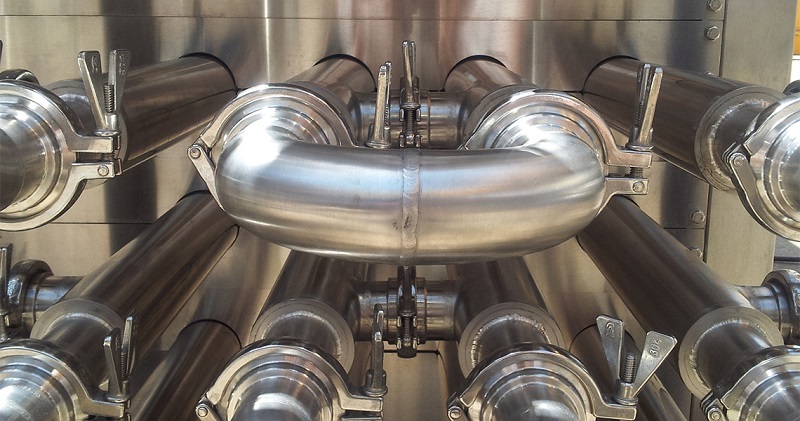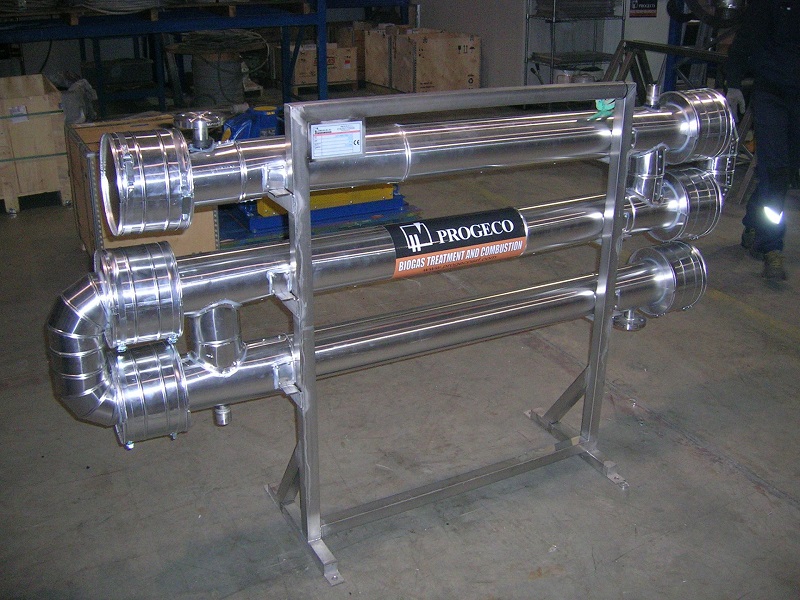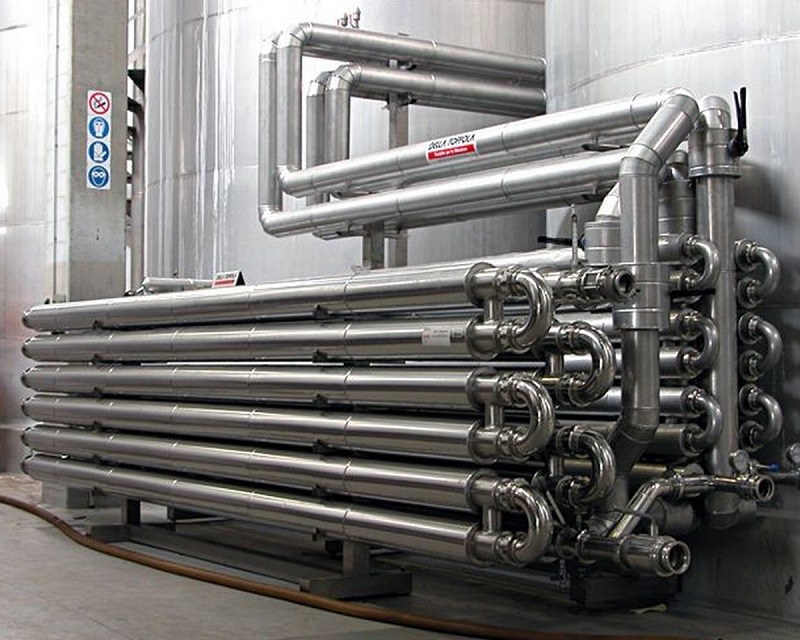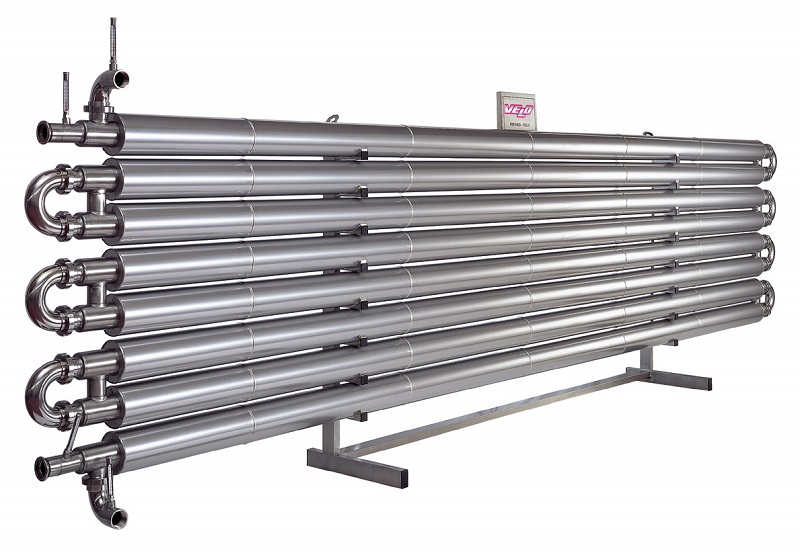The tube-in-tube heat exchanger is used for efficient heat transfer between two fluids. Tube-in-tube heat exchanger finds their application in industries where heat treatment is subjected to fluids of high viscosity, density, or high fiber or solid particle contamination. In this article, we find the best answer to the question of what is a tube-in-tube heat exchanger and discuss an overview of all you need to know about this type of heat exchanger. Follow this new blog in Linquip to find out more about diesel engine working procedures.
What Is Tube In Tube Heat Exchangers?
Double-tube heat exchangers are designed whereby one tube is concentrically positioned within a larger tube. The double tube composition allows for unrestricted flow of product, making it the ideal heat exchanger for viscous products. The product flows through the inner tube and the service fluid flows through the space between the two tubes, through the surrounding shell.
Tube-in-tube heat exchangers are specially designed for heating or cooling products with low-medium viscosity. The great advantage of the tube-in-tube heat exchangers is to be able to process products with fibers or particles, without the risk of clogging. The large diameter of the tubes ensures their free flow. This heat exchanger is dismountable which makes mechanical cleaning possible. Special construction and corrosion-resistant materials ensure its long service life.
Parts
To answer the question of what is a tube-in-tube heat exchanger, first, let us see what are the different parts of these exchangers. The equipment consists of a single tube mounted inside an outer shell tube, so that the product flows counter-current through the inner tube, with the service medium around it. The diameter of the inner tube is smaller than the outer tube. The inner tube is placed within the outer tube in a concentric circle kind of shape.
The tubular heat exchanger modules are normally connected in series and mounted on a frame. The product medium inside the tube flows in counter current to the service medium. The product tube is corrugated, or it can be smooth. The shell tube is always smooth.
Design
Its unique and compact design prevents thermal fatigue, increases efficiency, and reduces the overall size. It is ideal for high-temperature, high-pressure, and low-flow applications. The layout of tube-in-tube heat exchangers can be customized to fit the available installation footprint or other customer requests. The use of flanged connections allows these tubular heat exchangers to be disassembled to facilitate cleaning and maintenance tasks. The design is being used by major OEMs around the world and in the ever-expanding wholesale replacement market. The simplicity of design and installation makes this product ideal in both markets.
Performance Features
- Heat transfer rates to 100,000 BTU/hr (29 kW)
- Liquid flows to 10 GPM (38 LPM)
- Pressures up to 4,500 psi (310 bar)
- Working temperatures up to152°C
- Can achieve Reynolds tubular flow
- Corrugated internal tube to give added heat transfer area
Working Principle
The working principle of this heat exchanger is simple. A tube-in-tube heat exchanger can achieve a pure countercurrent flow, which allows a temperature crossover to be achieved so that the cold fluid can be heated above the hot fluid outlet temperature. The heated or cooled fluid never comes into contact with the fluid to which it is heating or cooling. The inner and the outer tube each one carries the heated or cooled fluid. This method is known as the indirect heat transfer method.
The fluid in the outer tube enters the tube from the opposite end of the tube to the fluid in the internal tube. This is called counter-flow or contraflow. Tube-in-tube heat exchangers find use in the preheating and cooling sections where a direct steam injection heat exchanger is needed. The heat exchangers on the preheat and cooling sections are by the indirect heat transfer method but the final heating is done by injecting steam directly into the product which is known as the direct steam injection or direct steam infusion.
Types
Three types of the tube in tube heat exchangers for a variety of applications are as follows:
- Sanitary Double Tube Heat Exchangers
Sanitary tubes in tube heat exchangers consist of two tubes, an inner and an outer coiled together. These sanitary models are designed to meet the high-quality requirements and hygienic standards of the pharmaceutical industry. There is no risk of cross-contamination between the product and working fluids.
- Industrial Double Tube Heat Exchangers
In this design, the inner tube is corrugated for increased heat transfer and reduced fouling. As the name suggests, it is designed for industrial applications
- Industrial Double Tube Heat Exchangers with Removable Tube
In this type of heat exchanger, the inner tube is removable which allows for easier and faster inspection/cleaning consequently reducing operational downtime required for high-fouling products. The tube-in-tube concentric geometry makes it easy to work with fluids that contain particles, without having to worry about blockages impeding the flow of product. Special corrugated tubes make it more efficient than similar smooth tube heat exchanger designs.
Advantages
- Higher thermal efficiency due to corrugated tubes
- Easy to clean
- Low maintenance
- Robust
- All hygienic fittings
- High particulate capacities
- Resistant to fouling
- Flexibility in materials of construction from carbon steel to special alloys
- Can handle high-viscosity product
- Meets the required industry standard for CIP cleaning. Minimum 1.5 meters per second velocity
Disadvantages
- Need more space due to the reduced heat exchange surface area
Applications
The tube-in-tube heat exchangers are typically applied for:
- Multi-phase fluids and slurries
- High thermal stress
- Steam condensing
- Seal cooling
- Liquid/gas
- Sampling
- WFI (Water For Injection)
Tube-in-tube heat exchangers are specifically designed for use in water-cooled condensers, water chillers, paper industry, and water source heat pumps.
Here are some examples of the tube in tube heat exchangers uses in different fields:
Industrial
- Palm Oil
- Fine Chemicals
- Solvents
- Petrochemicals
- Process Water
Pharmaceutical
- Lotions
- Creams
- Gels
- Cosmetics
Chemical
- Heating of pastes in the production of PET pellets
Food
- Prepared food
- Vegetables
- Fruit puree and concentrates
- Fruit Dice, rounds, and slices
- Fruit jams and marmalades
- Soups
- Baby foods
- Mayonnaise
- Soy
- Puddings and desserts
- Whey, casein, and lactose products
- Yogurt and cultured milk
- cream and ice cream
- Sauces
- Beverages
Environmental
- Sewage treatment
- Cooling or heating of wastewater
- Anaerobic digestion (AD) and biogas
- Pasteurization of sludge
So, there you have every single fact to the question of what is a tube-in-tube heat exchanger. If you enjoyed this article in Linquip, let us know by leaving a reply in the comment section. Is there any question we can help you with? Feel free to sign up on our website to get the most professional advice from our experts
Buy Equipment or Ask for a Service
By using Linquip RFQ Service, you can expect to receive quotations from various suppliers across multiple industries and regions.
Click Here to Request a Quotation From Suppliers and Service Providers
Read More on Linquip
- Quick Guide On What Is Floating Head Exchanger
- Types of Heat Exchangers: An Introduction to All Essential Specifications
- What is Plate Heat Exchanger?
- What is a U-tube heat exchanger? An undeniably advantageous system
- Demystifying Heat Exchanger Sizing: A Comprehensive Guide
- Heat Exchanger vs. Chiller: Which One is the Best for You?
- Difference Between Heat Exchanger and Condenser: A thorough guide 2023
- Heat Exchanger Efficiency Calculation & Equation
- Tubular Heat Exchangers: Usage & Working Principle
- What is Coil Heat Exchanger? Design Example
- What is Scraped Surface Heat Exchanger? Find it Where it is used
- Working Principle of Plate Heat Exchanger
- Types of Shell and Tube Heat Exchangers







